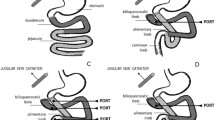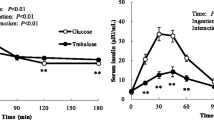Abstract
The pharmacokinetics of lorazepam was examined in 10 male patients with insulin-dependent diabetes mellitus before and following treatment with neomycin and cholestyramine. Neomycin and cholestyramine were given in an attempt to block the enterohepatic circulation of lorazepam and so to permit an in vivo estimate of hepatic glucuronidation. The volume of distribution and clearance of free lorazepam in diabetic patients were not significantly different from the corresponding estimates in 14 normal controls. Neomycin and cholestyramine increased the clearance of lorazepam by 63% consistent with their effect in non-diabetic controls. However, patients on beef/pork insulin exhibited a greater than normal increase on this interupting regimen (125%), and had a significantly greater neomycin/cholestyramine cycling-interrupted clearance of lorazepam than either normal controls or patients on human insulin (15.4 vs. 6.96 and 7.87 ml·min−1·kg−1). The clearance was correlated positively and significantly with HbA1c and glycated proteins (fructosamine), but only in patients on human insulin. Thus, the pharmacokinetics of lorazepam was not altered in patients with insulin-dependent diabetes mellitus. However, it is possible that there are differences in the rate and extent of hepatic glucuronidation and enterohepatic circulation of lorazepam between patients treated with beef/pork and human insulins and between diabetics treated with beef/pork insulin and non-diabetic controls.
Similar content being viewed by others
References
Hinohara Y, Takanashi S, Nagashima R, Shioya A (1974) Glucuronic acid pathway in alloxan diabetic rabbits. I. Urinary excretion of metabolites related to the glucuronic acid pathway. Jap J Pharmacol 24:869–878
Sochor M, Baquer NZ, McLean P (1979) Regulation of pathways of glucose metabolism in kidney. The effect of experimental diabetes on the activity of the pentose phosphate pathway and the glucuronate-xylulose pathway. Arch Biochem Biophys 198:632–646
Sochor M, Kunjara S, Greenbaum AL, McLean P (1986) Renal hypertrophy in experimental diabetes. Effect of diabetes on the pathways of glucose metabolism: differential response in adult and immature rats. Biochem J 234:573–577
Dajani RM, Kayyali SY (1973) The biotransformation of acetophenetidin in the alloxan-diabetic rabbit. Comp Gen Pharmacol 4:23–35
Eacho PI, Sweeny D, Weiner M (1981) Conjugation of p-nitroanisole and p-nitrophenol in hepatocytes isolated from streptozotocin diabetic rats. J Pharmacol Exp Ther 218:34–40
Price VF, Jollow DJ (1982) Increased resistance of diabetic rats to acetaminophen-induced hepatotoxicity. J Pharmacol Exp Ther 220:504–513
Morrison MH, Hawksworth GM (1984) Glucuronic acid conjugation by hepatic microsomal fractions isolated from streptozotocin-induced diabetic rats. Biochem Pharmacol 33:3833–3838
Morrison MH, Barber HE, Foschi PG, Hawksworth GM (1986) The kinetics of 4-nitrophenol conjugation by perfused livers and hepatic microsomes from streptozotocin induced diabetic rats. J Pharm Pharmacol 38:188–194
Vega P, Gaule C, Sanchez E, del Villar E (1986) Inhibition and activation of UDP-glucuronyltransferase in alloxan diabetic rat. Gen Pharmacol 17:641–645
Watkins JB, Dykstra TP (1987) Alterations in biliary excretion function by streptozotocin-induced diabetes. Drug Metab Dispos 15:177–183
Daintith H, Stevenson IH, O'Malley K (1976) Influence of diabetes mellitus on drug metabolism in man. Int J Clin Pharmacol Biopharm 13:55–58
Murali KV, Adithan C, Shashindran CH, Gambhir SS, Chandrasekar S (1983) Antipyrine metabolism in patients with diabetes mellitus. Clin Exp Pharmacol Physiol 10:7–13
Ruiz-Cabello F, Erill S (1984) Abnormal serum protein binding of acidic drugs in diabetes mellitus. Clin Pharmacol Ther 36:691–695
Zysset T, Wietholtz H (1988) Differential effect of type I and type II diabetes on antipyrine disposition in man. Eur J Clin Pharmacol 34:369–375
Adithan C, Danda D, Swaminathan RP, Indhiresan J, Shashindran CH, Bapna JS, Chandrasekar S (1988) Effect of diabetes mellitus on salivary paracetamol elimination. Clin Exp Pharmacol Physiol 15:465–471
Adithan C, Sriram G, Swaminathan RP, Krishnan M, Bapna JS, Chandrasekar S (1989) Effect of type II diabetes mellitus on theophylline elimination. Int J Clin Pharmacol 27:258–260
Gitanjali B, Adithan C, Raveendran R, Shashindran CH, Chandrasekar S (1992) Pharmacokinetics of single dose oral digoxin in patients with uncomplicated type II diabetes mellitus. Int J Clin Pharmacol 30:113–116
Greenblatt DJ, Schillings RT, Kyriakopoulos AA, Shader RI, Sisenwine SF, Knowles JA, Ruelius HW (1976) Clinical pharmacokinetics of lorazepam. I. Absorption and disposition of oral 14-C lorazepam. Clin Pharmacol Ther 20:329–341
Ruelius HW (1978) Comparative metabolism of lorazepam in man and four animal species. J Clin Psychiatry 39:11–15
Wilkinson GR, Shand DG (1975) A physiological approach to hepatic drug clearance. Clin Pharmacol Ther 18:377–390
Crom WR, Webster SL, Bobo L, Teresi ME, Relling MV, Evans WE (1987) Simultaneous administration of multiple model substrates to assess hepatic drug clearance. Clin Pharmacol Ther 41:645–650
Herman RJ, Van Pham JD, Szakacs CBN (1989) Disposition of lorazepam in human beings: enterohepatic recirculation and first-pass effect. Clin Pharmacol Ther 46:18–25
Chaudhary A, Lane RA, Woo D, Herman RJ (1993) Multipledose lorazepam kinetics:shuttling of lorazepam glucuronide between the circulation and the gut during day-time and nighttime dosing intervals in response to feeding. J Pharmacol Exp Ther 267:1034–1038
Herman RJ, Chaudhary A, Szakacs CBN (1994) Disposition of lorazepam in Gilbert's syndrome: effects of fasting, feeding and enterohepatic circulation. J Clin Pharmacol 34:978–984
Tozer TN, Gambertoglio JG, Furst DE, Avery DS, Holford HG (1983) Volume shifts and binding estimates using equilibrium dialysis: application to prednisolone binding in humans. J Pharm Sci 72:1442–1446
Yamaoka K, Nakagawa T, Uno T (1978) Application of Akaike's information criterion (AIC) in the evaluation of linear pharmacokinetic equation. J Pharmacokinet Biopharm 6:165–175
Boxenbaum HG, Riegelman S, Elashoff RM (1974) Statistical estimations in pharmacokinetics. J Pharmacokinet Biopharm 2:123–148
Yeh KC, Kwan KC (1978) A comparison of numerical integrating algorithms by trapezoidal, Lagrange, and spline approximations. J Pharmacokinet Biopharm 6:79–98
Gibaldi M, Perrier D (1982) Noncompartmental analysis based on statistical moment theory. In: Gibaldi M, Perrier D (eds) Pharmacokinetics. Dekker, New York, pp 409–417
Narango CA, Sellers EM, Giles HG, Abel JG (1980) Diurnal variations in plasma diazepam concentrations associated with reciprocal changes in free fraction. Br J Clin Pharmacol 9:265–272
Sjobom NC, Lins PE, Adamson U, Theodorsson E (1990) A comparative study on the hormonal responses to insulin-induced hypoglycemia using semisynthetic human insulin and pork insulin in patients with type 1 diabetes mellitus. Diabetic Med 7:775–779
Tattersall RB, Gill GV (1991) Unexplained deaths of type-I diabetic patients. Diabetic Med 8:49–58
Dahlan AA, Vrbancic MI, Hogan TE, Woo D, Herman RJ (1993) Greater sedative response to lorazepam in patients with insulin-dependent diabetes mellitus while on treatment with beef/pork versus human insulin. Clin Invest Med 16:18B
Kern W, Schlosser C, Kerner W, Pietrowsky R, Born J, Fehm HL (1994) Evidence for effects of insulin on sensory processing in humans. Diabetes 43:351–356
King GL, Kahn CR (1981) Non-parallel evolution of metabolic and growth-promoting functions of insulin. Nature 292:644–646
Kahn CR, Shechter Y (1990) Insulin, oral hypoglycemic agents, and the pharmacology of the endocrine pancreas. In: Gilman AG, Rall TW, Nies AS, Taylor P (eds) Goodman and Gilman's The Pharmacological Basis of Therapeutics. Permagon, Toronto, pp 1463–1495
Sesti G, Marini MA, Montemurro A, Borboni P, Di Cola G, Bertoli A, De Pirro R, Lauro R (1991) Evidence that human and porcine insulin differently affect the human insulin receptor: studies with monoclonal anti-insulin receptor antibodies. J Endocrinol Invest 14:913–918
Mosthaf L, Grako K, Dull TJ, Coussens L, Ullrich A, McClain DA (1990) Functionally distinct insulin receptors generated by tissue-specific alternative splicing. EMBO 9:2409–2413
Rosenzweig A, Zetterstrom C, Benjamin A (1990) Identification of retinal insulin receptors using site-specific antibodies to a carboxy-terminal peptide of the human receptor alpha-subunit. Up-regulation of neuronal insulin receptors in diabetes. J Biol Chem 265:18030–18034
Olefsky JM (1990) The insulin receptor. A multifunctional protein. Diabetes 39:1009–1016
McClain DA, Maegawa H, Thies RS, Olefsky JM (1990) Dissection of the growth versus metabolic effects of insulin and insulin-like growth factor-I in transfected cells expressing kinase-defective human insulin receptors. J Biol Chem 265:1678–1682
Takata Y, Webster NJ, Olefsky JM (1991) Mutation of the two carboxy-terminal tyrosines results in an insulin receptor with normal metabolic signaling but enhanced mitogenic signaling properties. J Biol Chem 266:9135–9139
Author information
Authors and Affiliations
Rights and permissions
About this article
Cite this article
Herman, R.J., Chaudhary, A., Szakacs, C.B. et al. Disposition of lorazepam in diabetes: differences between patients treated with beef/pork and human insulins. Eur J Clin Pharmacol 48, 253–258 (1995). https://doi.org/10.1007/BF00198307
Received:
Accepted:
Issue Date:
DOI: https://doi.org/10.1007/BF00198307




